Bosnia and Herzegovina
Culture Name
Bosnian; Herzegovinan
Orientation
Identification. The name "Bosnia" is derived from the Bosna River, which cuts through the region. Herzegovina takes its name from the word herceg, which designated the duke who ruled the southern part of the region until the Ottoman invasion in the fifteenth century. The two regions are culturally indistinguishable and for much of their history have been united under one government. Although cultural variations in Bosnia and Herzegovina are minimal, cultural identity is currently extremely divisive. The three main groups are Muslims (Bosniacs), Serbs, and Croats. Before the recent civil war, many areas of the country had mixed populations; now the population has become much more homogeneous in most regions.
Location and Geography. Bosnia is in southeastern Europe on the Balkan Peninsula, bordering Slovenia to the northwest, Croatia to the north, and Serbia and Montenegro to the south and southwest; it has a tiny coastline along the Adriatic Sea. The land area is 19,741 square miles (51,129 square kilometers). Herzegovina is the southern portion of the country; it is shaped like a triangle whose tip (surrounded by Croatia and Yugoslavia) touches the Adriatic. Northern Bosnia is characterized by plains and plateaus. The central and southern regions are mountainous. The Dinaric Alps that cover this area also extend southward into Serbia and Montenegro. These regions, including the area around Sarajevo, the capital, are conducive to skiing and other winter sports and before the civil war were a popular tourist destination. Much of the land (39 percent) is forested; only 14 percent is arable. Most of the farmland is in the northern part of the country.
The climate varies from cold winters and mild, rainy summers in the mountains to milder winters and hot, dry summers in the rest of the country and a more Mediterranean climate near the coast. The entire region is vulnerable to severe earthquakes. Bosnia also suffers from air and water pollution because of poorly regulated industrial production in the years before the civil war.
Demography. The population was 4,364,574 in 1991. A U.S. estimate of the population in July 2000 was 3,835,777; however, that figure is not reliable as a result of dislocations and deaths from military activity and ethnic cleansing. In 1991, approximately 44 percent of the people were Bosniac, 31 percent were Serb, 17 percent were Croat, 5.5 percent were Yugoslav (of mixed ethnicity), and 2.5 percent were of other ethnicities. Since that time, the Bosniac population has declined and that of the Serbs has risen because of ethnic cleansing by the Serbian army. (The terms "Bosniac" and "Muslim" often are used interchangeably; "Bosniac" refers more explicitly to an ethnicity, to avoid confusion with the term "Muslim," which refers to any follower of the Islamic faith.)
Since 1995, the country has been internally divided into a Bosniac/Croat Federation, which controls 51 percent of the land and whose majority is Bosniac and Croat, and a Serb Republic, which has the other 49 percent and has a Serb majority. Herzegovina, which borders Croatia, has historically had a Croat majority.
Linguistic Affiliation. Croatian, Serbian, and Bosnian are virtually identical; the distinction among them is a matter of identity politics. Serbians write their language in the Cyrillic alphabet, whereas Croatian and Bosnian use the Latin script. Turkish and Albanian are spoken by a small minority.
Symbolism. The flag is blue, with a yellow isosceles triangle to the upper right and seven five-pointed
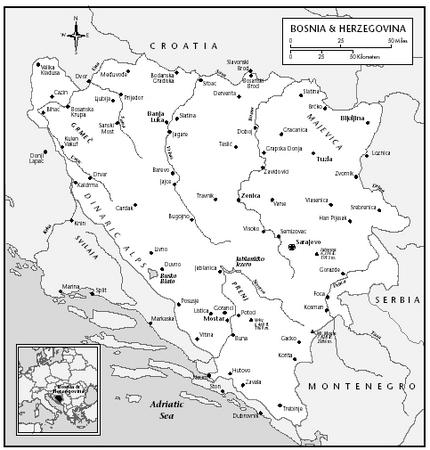
History and Ethnic Relations
Emergence of the Nation. The first known inhabitants of the region were the Illyrians. The Romans conquered the area in 167 B.C.E. In 395 C.E. , the Roman Empire was split into Byzantium in the east and the Western Roman Empire in the west. The dividing line was the Drina River, which today forms the border between Bosnia and Serbia. Bosnia took on a special significance as the boundary region between the two empires.
The Slavs arrived in the Balkans around 600 C.E. , migrating from the north. Bosnia changed hands numerous times. It first gained independence from Serbia in 960, although the relationship with its neighbor to the south continued to be negotiated.
Bosnia became part of the Hungarian Empire in the thirteenth century and gained independence again in the early 1300s. Internal fighting continued, however, until the Bosnian king Steven Tvrtko united the country. In 1376, he declared himself ruler not just of Bosnia but of Serbia as well.
The Ottoman Empire began to attack the region in 1383, eventually incorporating Bosnia as a Turkish province. During the almost four hundred years in which the Ottomans dominated the area, Bosnians adopted many elements of Turkish culture, including religion; the majority of the people converted from Roman Catholicism or Eastern Orthodox Christianity to Islam. Because of Bosnia's position on the border between the Islamic power to the east and the Christian nations to the west, the Turks held on to the area tenaciously, particularly as their empire began to weaken in the sixteenth and seventeenth centuries. In the mid-nineteenth century, Bosnians joined Slavs from Serbia and Croatia in an uprising against the Turks. Austria-Hungary, with the aid of the Russians, took advantage of the Turks' weakened position and invaded Bosnia-Herzegovina, annexing the region in 1908. The Bosnians were bitter at having repulsed the Turks only to be occupied by another outside force but were powerless to repel the new rulers.
In 1914, a Bosnian Serb nationalist assassinated Austrian Archduke Franz Ferdinand in Sarajevo, and Austria declared war on Serbia. World War I spread throughout Europe, ending four years later in the defeat of Austria-Hungary and its German allies. The Kingdom of the Serbs (Serbia, Montenegro, Croatia, and Slovenia) was formed in 1918, and Bosnia was annexed to the new nation. Dissension continued among the different regions of the kingdom, and in an effort to establish unity King Alexander I renamed the country Yugoslavia in 1929. The extreme measures he took, which included abolishing the constitution, were largely unpopular, and Alexander was assassinated in 1934 by Croatian nationalists.
In the 1930s, fascism began to claim many adherents in Croatia, fueled by strong nationalist sentiments and in response to the Nazi movement in Germany. In 1941, Yugoslavia was thrust into World War II when Germany and Italy invaded the country. Thousands of people were killed, and Belgrade was destroyed. Yugoslav troops resisted the invasion but fell after eleven days of fighting. The Germans occupied the country, installing a puppet government in Croatia. Croatian troops took part in the German program of ethnic cleansing, killing thousands of Jews, Gypsies, Serbs, and members of other ethnic groups. Two main resistance movements arose. The Chetniks were Serbian nationalists; the Partisans, under the leadership of the communist Josip Broz Tito, attempted to unite Yugoslavs of all ethnicities. The two groups fought each other, which weakened them in their struggle against the foreign powers. The Partisans managed to expel the Germans only after the Allies offered their support to the group in 1943.
When the war ended in 1945, Tito declared himself president of Yugoslavia. He won an election several months later, after outlawing opposing parties. Bosnia-Herzegovina was granted the status of a republic in 1948.
Tito nationalized businesses and industry in a manner similar to the Soviet system; however, Tito's Yugoslavia managed to maintain autonomy from the Soviet Union. He ruled with an iron fist, outlawing free speech and suppressing opposition to the regime. While ethnic and regional conflicts continued among the six republics (Serbia, Bosnia-Herzegovina, Croatia, Slovenia, Macedonia, and Montenegro), Tito suppressed them before they became a threat to the unity of the country.
Tito died in 1980 and his government was replaced by another communist regime. Power rotated within a state presidency whose members included one representative of each of the six republics and two provinces. This system contributed to growing political instability, as did food shortages, economic hardship, and the example of crumbing regimes in other Eastern European countries.
By the late 1980s, there was a growing desire in most of the republics for more autonomy and democratization. In 1989, however, the nationalist Slobodan Milosevic won the presidency in Serbia. Milosevic, with his vision of a "Greater Serbia" free of all other ethnicities, manipulated the media and played on Serbians' fears and nationalist sentiments.
Other Yugoslav republics held their first free elections in 1990. A nationalist party won in Croatia, and a Muslim party won in Bosnia-Herzegovina. The republics of Slovenia and Croatia declared independence in 1991. Because of its strong military and small population of Serbs, Milosevic allowed Slovenia to secede with little resistance. The Croatian declaration of independence, however, was met with a war that lasted into 1992.
In Bosnia, the Muslim party united with the Bosnian Croats and, after a public referendum, declared independence from Serbia in 1992. The Serbs in the republic's parliament withdrew in protest, setting up their own legislature. Bosnia's independence was recognized internationally, and the Muslim president promised that Bosnian Serbs would have equal rights. Those Serbs, however, supported by Milosevic, did not agree to negotiations. The Serbian army forced the Muslims out of northern and eastern Bosnia, the areas nearest to Serbia. They used brutal tactics, destroying villages and terrorizing civilians. Bosnians attempted to defend themselves but were overpowered by the Serbians' superior military technology and equipment.
One of the tactics Serb forces used throughout the war was the systematic rape of Bosnian women. Commanders often ordered their soldiers to rape entire villages. This atrocity has left permanent scars on much of the population.
In November 1992, the presidents of Serbia and Croatia decided to divide Bosnia between them. This resulted in increased fighting between Croats and Muslims as well as between Muslims and Serbs. In that month, six thousand United Nations (UN) troops were deployed in Bosnia as peacekeepers and to ensure the delivery of aid shipments. The UN troops were powerless to act, however, and the atrocities continued.
Many cities were in a state of siege, including Sarajevo, Srebrenica, and Gorazde. There were extreme shortages of food, water, fuel, and other necessities. Those who chose to flee often ended up in refugee camps with dreadful living conditions; the unlucky were sent to Serb-run concentration camps where beatings, torture, and mass murder were common.
In 1993, the UN declared six "safe havens" in Bosnia where fighting was supposed to cease and the population would be protected. This policy proved ineffective, as war continued unabated in all six areas. After a Serb attack on a Sarajevo market that resulted in the death of sixty-eight civilians, the UN decided to step in more forcefully.
In August 1995 a peace conference was held in the United States, resulting in the Dayton Peace Accords, an agreement that Bosnia-Herzegovina would revert to the boundaries in place before the fighting began and that the country would be divided into two parts: the Federation of Bosnia and Herzegovina (run jointly by Muslims and Croats) and the Serb Republic of Bosnia and Herzegovina. The agreement was signed in December, and NATO forces were sent to maintain the peace. The NATO troops are still a significant presence in Bosnia, with approximately thirty-four thousand in the area. The peace is tenuous, however, and recent fighting between Muslims and Serbs in nearby Kosovo has exacerbated ethnic tensions.
National Identity. National identity for Bosnians is inextricably tied to ethnic and religious identity. The majority of Bosnians are Muslim, and their culture bears many traces of the Turkish civilization that predominated in the region for centuries. Bosnian Muslims tend to identify themselves in opposition to Serbia and its long-standing domination of the region. Bosnian Serbs, who are primarily Eastern Orthodox and share a culture with their Serb neighbors to the south, identify less as Bosnians and primarily as Serbs. Croats, who are mostly Roman Catholic, distinguish themselves from both Serbs and Bosnians. Before the civil war forced them into separate camps, all three groups also identified strongly as Bosnian.
Ethnic Relations. The entire Balkan region has historically been called the powder keg of Europe because of volatile relations both among local groups and with outside forces. Bosnia, however, has a long history of relatively peaceful coexistence among its three main ethnic groups. Before the 1990s, intermarriage was common, as were mixed communities. When Milosevic rose to power in Yugoslavia in 1989, his extremist politics stirred latent distrust among the ethnic groups. When Bosnia declared independence in 1992, his government began a campaign of "ethnic cleansing" that has left millions dead, wounded, or homeless. While it is the Serbs, with the backing of Milosevic, who have been responsible for most of the atrocities, Croats also have persecuted Bosnian Muslims.
Urbanism, Architecture, and the Use of Space
Approximately 42 percent of the population lives in towns or cities. Sarajevo, near the center of the country in a valley of the Dinaric Alps, is the capital and largest city. Once a cultural center and tourist destination (it was the site of the 1984 Winter Olympics), it has been devastated by the civil war. Before the war, it was a vibrant, cosmopolitan mixture of the old and the new, with skyscrapers and modern buildings standing alongside ancient Turkish mosques and marketplaces. Today many of these buildings are in rubble, and food and electricity are in short supply. Despite its desperate situation, Sarajevo has taken in many refugees from other parts of the country. Even amid the destruction, however, there is evidence of Sarajevo's glorious past. The Turkish Quarter boasts the Gazi
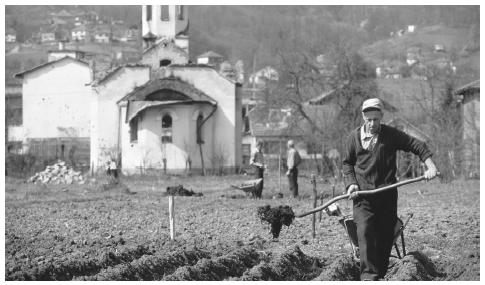
Mostar, the largest city in the Herzegovina region, also has been devastated by the civil war. Other major cities include Banja Luka, Zenica, and Tuzla. Before the war, housing in the cities consisted primarily of concrete apartment buildings. Many of those structures were destroyed during the war, and despite efforts at rebuilding, many remain unlivable. People have been forced into crowded living situations with little privacy.
In rural areas, which are much less densely populated, the effects of war have been less extreme. Most of those houses are small structures of stone or wood. Before the war, the majority of them were equipped with electricity and running water.
Food and Economy
Food in Daily Life. Bosnian food has been influenced by both Turkish and Eastern European cuisine. Grilled meat is popular, as are cabbage-based dishes. Bosanski Ionac is a cabbage and meat stew. Cevapcici are lamb sausages that often are eaten with a flat bread called somun. Pastries, both sweet and savory, are common; burek and pida (layered cheese or meat pies), zeljanica (spinach pie), and sirnica (cheese pie) are served as main dishes. Baklava, a Turkish pastry made of phyllo dough layered with nuts and honey, is a popular dessert, as is an apple cake called tufahije. Kefir, a thin yogurt drink, is popular, as are Turkish coffee and a kind of tea called salep. Homemade brandy, called rakija, is a popular alcoholic drink. Alcohol use is down since the rise in Muslim influence, and in certain areas of the country drinking has been prohibited.
Food Customs at Ceremonial Occasions. For Bosnian Muslims, the end of Ramadan (a month of fasting from sunrise to sunset) is celebrated with a large family meal and with Turkish-style sweets and pastries. Both Catholics and Eastern Orthodox believers celebrate Easter with special breads and elaborately decorated eggs. Christmas is an occasion for special family meals among the Christian population.
Basic Economy. Bosnia is the second poorest republic of the former Yugoslavia. The agricultural sector, which accounts for 19 percent of the gross domestic product (GDP), does not produce enough
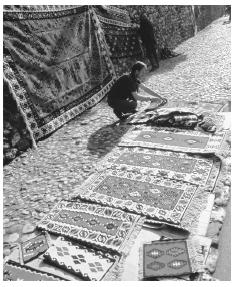
Land Tenure and Property. Tito nationalized many of Yugoslavia's farms into collectives. This proved unsuccessful, and he modified the system by giving farmers more control over production. Today, many farms are privately owned. While 90 percent of the country's firms are private, the large government conglomerates are still in place. This has hindered progress toward privatization, as has widespread corruption.
Commercial Activities. Crops produced for domestic sale include corn, barley, oats, wheat, potatoes, and fruits. The war has caused severe shortages of food, electricity, and other goods. There is an active black market on which some otherwise unavailable goods can be bought for exorbitant prices.
Major Industries. The main industries are mining (coal, iron ore, lead), vehicle assembly, textiles, domestic appliances, oil refining, and military supplies. Much of the production capacity has been damaged or shut down since the early 1990s. There is a negative growth rate of 5 to 10 percent in the country's industries.
Trade. The main imports are raw materials, petroleum-based fuels, and consumer goods. The primary exports are machinery, clothing and footwear, and chemicals. Other republics of the former Yugoslavia and Western European nations are the main trading partners. During the war, Serbia and Croatia placed strict restrictions on trade with Bosnia, further damaging the economy.
Division of Labor. Under communism, the composition of the workforce shifted from an agricultural base to an industrial one. The more desirable jobs in government often were obtained through connections. Today, as the economy is beginning to recover from the civil war, jobs are difficult to come by in many fields, and connections are still useful.
Social Stratification
Classes and Castes. Before World War II, peasants formed the base of society, with a small upper class composed of government workers, professionals, merchants, and artisans and an even smaller middle class. Under communism, education, party membership, and rapid industrialization offered possibilities for upward mobility. The majority of the people had a comfortable lifestyle. The civil war drastically decreased the overall standard of living, and shortages and inflation have made necessary items unaffordable or unavailable. This situation has created more extreme differences between the rich and the poor, as those who have access to goods can hoard them and sell them for exorbitant rates. In general, the war stripped even the richest citizens of their wealth and left the majority of the population destitute.
Symbols of Social Stratification. Under Tito, Yugoslavia had a higher standard of living than did most countries in Eastern Europe; it was not uncommon for people in the cities to have cars, televisions, and other goods and appliances. The upper classes and higher-echelon government workers had more possessions and a higher standard of living. Today, luxuries of any sort are rare.
People generally dress in Western-style clothing. Muslim women can be distinguished by their attire; while they do not wear the full body covering common in other Islamic countries, they usually cover their heads with scarves. Traditional Serbian and Croatian costumes include caps, white blouses, and elaborately embroidered vests; they can be distinguished by the type of embroidery and other small variations. These outfits are worn only for special occasions such as weddings and festivals.
Political Life
Government. The legislature is bicameral. In the National House of Representatives, or Vijece Opcina, two-thirds of the seats are designated for the Bosniac/Croat Federation and one-third for the Serbian Republic; in the House of Peoples, or Vijece Gradanstvo, each ethnic group is guaranteed five seats. The presidency rotates every eight months among members of the three groups. These three presidents are elected by popular vote for four-year terms.
Leadership and Political Officials. Since the war, politics has splintered along ethnic lines. More than twenty political parties are represented in the government, most of them identified as Bosnian Muslim, Serb, or Croat. Bosnians are currently extremely wary of trusting a leader from a different ethnic group to represent their interests.
Social Problems and Control. The high rate of unemployment has led to an increase in crimes such as petty theft and carjacking. Unexploded land mines throughout the country are still a major concern. The Federation and the Republic have separate legal systems with trial and appellate courts.
One of the primary concerns today is prosecuting war criminals. An international war tribunal at the Hague has tried some perpetrators, but many others remain at large, including Slobodan Milosevic.
Military Activity. The Federation Army consists of separate Croatian and Bosniac elements. The Bosniac Army (the official army of the Federation) consists of forty thousand troops; the Croatians have sixteen thousand. The Army of the Serb Republic is composed solely of Bosnian Serbs and numbers around thirty thousand. Both federation and republican forces have air and air defense components that are subordinate to ground forces.
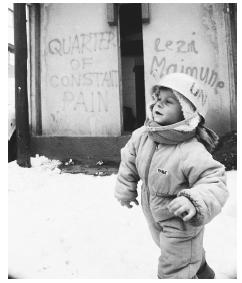
Social Welfare and Change Programs
Tito instituted a welfare system that provided for the poor, the elderly, and the mentally and physically disabled. His government also guaranteed women maternity leave and paid leave when their children were sick.
In independent Bosnia, the Muslim, Croat, and Serbian administrations provide aid for their respective populations. In the 1990s, the majority of the money for social services came from foreign aid organizations rather than from the government.
Nongovernmental Organizations and Other Associations
A number of international humanitarian groups have provided aid to help the country recover from the civil war. One of the largest of these groups is the International Committee of the Red Cross, which, in addition to providing aid and aid workers, investigated Serbian violations of the Geneva Conventions during the war. Other active groups include Christian Relief, World Vision, the International
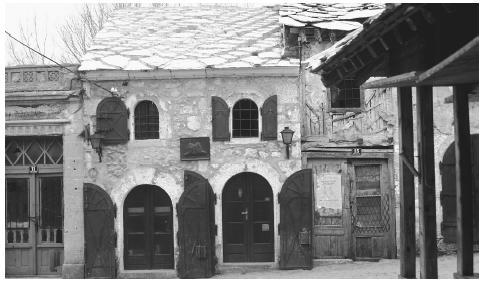
Gender Roles and Statuses
Division of Labor by Gender. Women are responsible for all domestic tasks, including cooking, cleaning, and child rearing. Women who work outside the home generally have lower-paying and lower-status jobs than men do. Since the economic devastation of the civil war, men are more likely to occupy the few jobs that are available, and more women have returned to the traditional roles of housewife and mother. Women are more equally represented in agriculture than they are in other fields, and the majority of elementary schoolteachers are women.
The Relative Status of Women and Men. Bosnia has a patriarchal tradition in which women are expected to be subservient to men. Both the Eastern European and Islamic traditions have contributed to this situation. Under Tito's administration, women were given complete civil and political rights. Educational and lifestyle opportunities have increased significantly since that time, although there are still disparities.
Marriage, Family, and Kinship
Marriage. Marriages are not arranged, and love matches are the norm. In 1991, before the civil war, 40 percent of the marriages registered involved ethnically mixed couples. Since that time, mixed marriages have become extremely rare. Despite Muslim sanctioning of polygamy, the custom was practiced in only one region of the country and currently is not practiced at all. It used to be customary for a bride's parents to give the couple a specially woven dowry rug containing the couple's initials and the wedding date.
Domestic Unit. The traditional domestic unit often includes parents, grandparents, and young children. This pattern has been disrupted in many cases, as the war forced thousands of people to flee their homes. Many were relocated to refugee camps or other countries, and thousands more were sent to concentration camps. Many mixed families have been torn apart by ethnic hatred, as children and spouses are forced to choose between ethnic affiliation and family ties.
Inheritance. Traditionally, inheritance follows a system of primogeniture, passing from the father
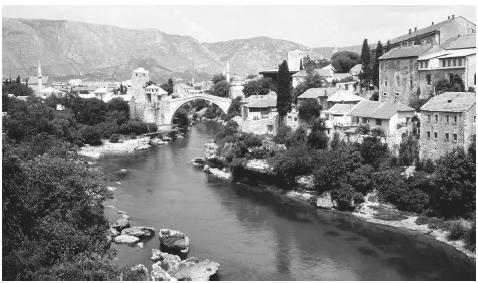
Kin Groups. As in the neighboring Slavic countries, Bosnians traditionally lived in zadruga, agricultural communities that ranged from two or three related nuclear families to as many as a hundred. Those communities were patriarchal and hierarchical in organization, with a male gospodar as the head. Most important decisions were made communally by the male members. While zadruga no longer exist in their original form, a person's extended family is still considered extremely important, especially in rural areas.
Socialization
Infant Care. Tito's government, which encouraged women to work outside the home, established state-run day-care centers for young children.
Child Rearing and Education. The current generation of children has witnessed unspeakable atrocities. Children were a prime target of snipers, especially in Sarajevo. Survivors suffer flashbacks, nightmares, and severe depression; in one survey, 90 percent of children surveyed in Sarajevo declared that they did not want to live. The country will be dealing with the effect of the war on these children for years.
Education is free and mandatory for children between the ages of seven and fourteen. There are Muslim schools where students study the Koran and Islamic law in addition to secular subjects and where boys and girls are taught in separate classrooms.
The educational system has been hard hit by the war. Schools were common targets of Serb mortar attacks, and many were forced to close. Some makeshift schools were organized in homes, but many children were left with no access to education. Since 1995, many schools have reopened.
Higher Education. The country has universities at Sarajevo, Banja Luka, Tuzla, and Mostar. After the civil war, the university in Mostar split into a Croat university in the western part of the city and a Muslim university in the eastern part.
Etiquette
Bosnians are known as a friendly, hospitable people. In Muslim houses, it is traditional to remove one's shoes and put on a pair of slippers. Kissing is a common form of greeting for both men and women. Three kisses on alternating cheeks are customary.
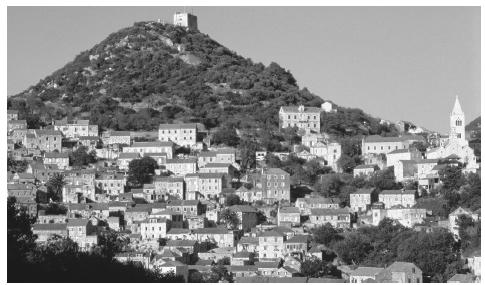
Religion
Religious Beliefs. Forty percent of the population is Muslim, 31 percent is Eastern Orthodox, 15 percent is Roman Catholic, and 4 percent is Protestant; 10 percent of the people follow other religions. Most of the population is not particularly observant, but religion is an important aspect of national identity. (Islam is associated with the Bosniacs, Eastern Orthodox with the Serbs, and Catholicism with the Croatians.)
Icons, which are images representing Christ, angels, saints, and other holy figures, hold an important place in Orthodox practice and are considered a connection between the earthly and spiritual realms.
Religious Practitioners. The central religious figures in Islam are called muezzins, scholars of the Koran who call the faithful to prayer. The Koran is seen as the ultimate authority in the religion. In the Eastern Orthodox religion, priests are the primary religious authorities; they are permitted to marry. The Eastern Orthodox religion does not recognize the authority of the Pope but follows a group of patriarchs who have equal status.
Rituals and Holy Places. Mosques are Muslim houses of worship. It is customary to remove one's shoes before entering. The prayer hall has no pews or seats; instead, worshipers kneel on prayer rugs. After Ramadan, people exchange small gifts, visit friends, and have a large family meal.
Eastern Orthodox religious ceremonies are held in elaborate, beautifully designed churches, many of which date back hundreds of years. Each family has a patron saint who is honored once a year in a large celebration called Krsna Slava. A candle is lit in the saint's honor, and special foods are consumed. Christmas (observed 6 and 7 January in the Orthodox Church) is a major holiday. Christmas Eve, called Badnje Vece, is celebrated with a large bonfire in the churchyard and the singing of hymns. In addition to church services, Easter is celebrated by dying eggs and performing traditional kolo dances.
Death and the Afterlife. Christians and Muslims mourn the death of a loved one by dressing in black and paying visits to the family of the deceased.
In the Eastern Orthodox tradition, funerals are large, elaborate occasions. In the cemetery, a spread of salads and roasted meats is presented in honor of the deceased; this is repeated a year after the death, at which point the gravestone is placed in the ground. Gravestones often bear photographs as well as inscriptions.
Medicine and Health Care
Tito's government significantly raised the standard of health, eliminating diseases such as typhus, tuberculosis, and whooping cough. More medical workers were trained, facilities were improved, and educational campaigns raised the general awareness of the population regarding health issues.
Many of the nation's health problems today stem from the destruction caused by the civil war. The medical system has been hard hit; facilities have been destroyed, and staffing and supplies are inadequate to deal with the enormous number of casualties. Despite the health workers and aid sent by charitable organizations, these problems continue to plague the health care system and have left it unable to meet even the basic medical needs of the population.
Secular Celebrations
The main secular holidays are New Year's Day, 1 January; Republic Day, 9 January (25 November in the Federation); Independence Day, 1 March; Day of the Army, 15 April; Labor Day, 1 May; and Victory Day, 4 May. There is an annual Sarajevo Film Festival in late August and a Winter Festival in February and March that is observed with theatrical and musical performances.
The Arts and Humanities
Support for the Arts. Under communism, artists who glorified the state received government funding; most other expression was censored. Since that time, artists have been given more creative freedom, although the religious establishment has used its political power to influence the art that is produced. There is virtually no money from public or private sources to support the arts.
Literature. The national literary tradition can be traced back to epic stories that were set to music and passed orally from one generation to the next. While not as prevalent today, this art form was still widely practiced as recently as the 1950s. Contemporary literature is concerned with history and identity politics. The most famous Bosnian writer is Ivo Andric, a Serbian Catholic who was raised in Bosnia and won the Nobel Prize in 1961 for the historical novel Bridge over the Drina. Mesa Selimovic, another novelist, was raised a Muslim but proclaimed himself a Serbian writer. Much of the literature produced in recent years has consisted of nonfiction accounts of the war. One such work is that of Zlata Filipovic, a twelve-year old girl whose diary describes everyday life in besieged Sarajevo.
Graphic Arts. Sarajevo and Mostar are well known for the wool rugs and carpets their artisans produce. Turkish influence is evident in the bright colors and geometric designs. Calligraphy and metalwork also reflect traditional Islamic styles. Silk embroidery is a traditional women's art. Contemporary graphic artists have used bullets, shrapnel, broken glass, ash, and other debris to make powerful statements.
The film director Emir Kusturica, a Bosnian with a Muslim background, achieved international acclaim for his 1984 film When Father Went Away on Business, which was nominated for an Academy Award in the United States. Since the civil war, Kusturica's work has been condemned by Muslim authorities, and he has moved to Serbia.
Performance Arts. Music in urban areas has strong echoes of the Turkish tradition. Singing is accompanied by the saz, a type of lute. In rural areas, the music draws more on Slavic influences. Ravne pesme is a "flat song" with little variation; ganga is a polyphonic song that sounds like shouting. The main instruments are the shargija (similar to the saz), the diple (a droneless bagpipe), and a wooden flute. Epic poems are performed to the accompaniment of a one-stringed fiddled called a gusle. Sevdalinka songs (from the Turkish word for love) are sentimental melodies usually sung by young women. They are performed throughout Bosnia and Herzegovina and have a strong cultural resonance in the entire country.
There are a variety of folk dances. Some are similar to the Serbian and Croatian forms. The nijemo kolo is a circle dance performed to foot stamping rather than music. There are also different line dances, some performed by men and others by women. Rock 'n' roll and popular dancing are popular and in some cases are replacing the more traditional forms.
The State of the Physical and Social Sciences
The physical and social sciences are virtually nonexistent since the civil war, and there are no funds available for these pursuits. The National and University Library was destroyed by Serbian bombings in 1992 and has not been rebuilt.
Bibliography
Benedek, Wolfgang, ed. Human Rights in Bosnia and Herzegovina after Dayton: From Theory to Practice 1999.
Bildt, Carl. Peace Journey: The Struggle for Peace in Bosnia, 1998.
Campbell, David. National Deconstruction: Violence, Identity, and Justice in Bosnia, 1998.
Chandler, David. Bosnia: Faking Democracy after Dayton, 1999.
"The Dismantled State of Bosnia." The Economist, June 28, 1997.
Doubt, Keith. Sociology after Bosnia and Kosovo: Recovering Justice, 2000.
Filipovic, Zlata. Zlata's Diary: A Child's Life in Sarajevo, 1994.
Glenny, Mischa. The Balkans: Nationalism, War, and the Great Powers, 1804–1999, 2000.
Hemon, Aleksander. Question in Bosnia, 2000.
Malcolm, Noel. Bosnia, A Short History 1994.
Mazower, Mark. The Balkans: A Short History, 2000.
Milojkovíc-Djuríc, Jelena. Panslavism and National Identity in Russia and the Balkans, 1830–1880: Images of the Self and Others, 1994.
Mojzes, Paul, ed. Religion and War in Bosnia, 1998.
"A Precarious Peace." The Economist, January 24, 1998.
Thompson, Mark. Forging War: The Media in Serbia, Croatia, and Bosnia-Hercegovina, 1999.
Web Sites
U.S. State Department, Central Intelligence Agency. "Bosnia." www.odci.gov/cia/publications/factbook/geos/bk.html
—E LEANOR S TANFORD
THANK YOU FOR THIS EXCELLENT ARTICLE!
I am from Azerbaijan-this country had bloody war too,as you know...
So thats why your article,helped me to know about military actions in other country.It would be excellent if you will write some day,about war of my country!Please if you will write something to may email,send me email of biljana peric, or another Bosnian!
I want to talk with Bosnian people about they war.
Thank you very much!
i would like to state that your article was very interesting, and i can see how you compared the three different types of people that live in Bosnia and Herzeovina. ( bosnians, serbs and croats. I would like to say that the country is doing well in terms of re-developing from what a devestation had occured, it may be a slow process but from when i visited there 6 years ago, it has come along way now. i am also pleased that you mentioned what these people did to this country, and how much they abused it. I do feel that you may not have mentioned enough about how terrible the torture camps were, and how they would give guns to little children and make them shoot people. i wanted to stress that those were the types of thigs that happened
thankyou
I had to do a power point about the Bosnia Genocide. its worth about 8 grades and hopefully i get a B on it!
THANK YOU SO MUCH!
Kindest regards,
Stephanie
Thank you.
thanx nat and nat
Thanks again
the wars,,and the education is low,,tat makes the country down,,,and the marraige relation is toworse...tat makes pity on this contry,,may god bless this country to come forward,,,,
Thank You!
PLEASE AN URGENT ANSWER IS REQUIRED!
NOW I DON'T HAVE TO FLUNK MY CLASS OVER BECAUSE I PASSED ALL BECAUSE OF THIS ARTICAL THAT GAVE SUCH AMAZING INFORMATION
THANkS:))
thank you once again
kind regards
manet Volim te
thanks!
Thanks
Coop In Utah
Congratulations and keep on sharing your knowledge...
Yours,
FG
Next time someone will ask me about my country more specifically, I'll send them over here.
Zdravo!
I am BOSNIAN and i know that CECA is not from Bosnia-Herzegovina :) :)
Nigel, United Kingdom
If there are any people with last name Gradjan, please contact me. I would like to find out more about my family history. Or Kunic form Jajce.
xx N
Anyways that's my opinion and I am probably bias
I like reading about different countries, their culture, tradition, everything about it. I was quite intrigued about the Slavic nations, Bosnia in particular. This article has quenched my thirst to know about this country.
Cheers to the author \m/.
Neil from Ahmedabad, India.
GOD be with you all,
Understanding
Would you kindly tell me about bosnian male marriage to a forign male?
The Pain, Damage and Loss caused by this war will last forever for some people, while others will not know about it or want to know about it. Most articles about the War in Bosnia are so focused on defining ethnic groups and religious differences. One might say the reason for War is there,- it is so easy to understand it now.
Before all, the question is what kind of a Human being is capable of taking another Human being's life and to do it in such way that no horror story can be compared with. What is is about the World we are living in and being so messed up all the time.
This War like many others can not be forgotten. Bosnian People have been Scared, influenced and dominated for centuries. One of the reasons for this, is that we are and always have been People of piece. People who believe in simple life. Our only history is the Greatness of our Families. With all the greed, hunger for wars and dominance. Perhaps we never had that chance to prove ourself s.
Histories in this World are written by the Strongest and True Lived and experienced by Weakest.
AM
There are certain things mentioned in the article that I personally do not agree with such as 3 kisses for greeting (that's not Bosnian way, we kiss once in each cheek) and also musicians mentioned are not Bosnians. Bosnian musicians and some of the legends are Halid Beslic, Dino Merlin, Hanka Paldum, Safet Isovic etc.
As great as the article is, one can not understand the full tradegy, emotions, feelings unless you have been through it.
Thanks and Regards
Peace
Even if they are 30 - 40 years old.
Greetings from the land of good people
fantastic article..
Thank you so much for posting this article.
Also, Bosnia did not have a civil war, but was attacked and invaded from foreign armies, supported by local ethnic groups organized as "states"
a. we don't border with Slovenia (that is Croatia)
b. we have never been part of Serbia and didn't gain independence from it, we were part of other empires and Yugoslavia
thanks once again